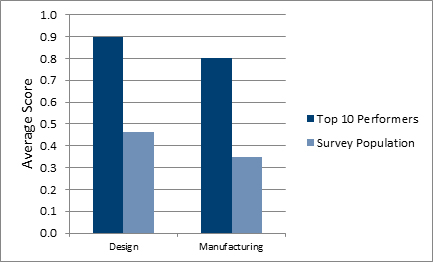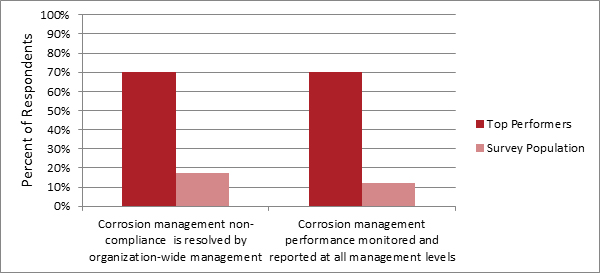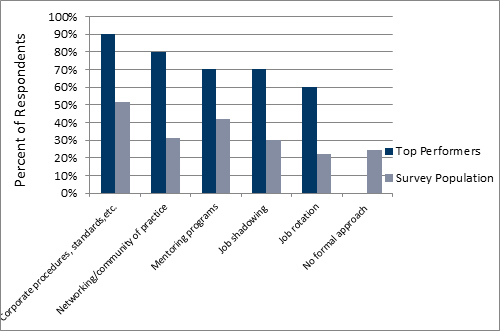Practices of the Top Performers in the Survey
The top performers based on the survey were those companies that had the top total average scores. From these top performers, common themes were extracted from the survey questions and identified as the “best practices” for corrosion management systems based on the self-assessment surveys. Typical drivers for a company to implement a CMS would include financial impact, environmental risks, safety issues, regulations, failures, public awareness, etc. Regardless of the motivation, it is obvious that corrosion issues have worked their way into the awareness of senior management in these top-performing organizations, such that critical aspects of a CMS are in place.
Top performers in the survey had several aspects of their corrosion program in common. The following are critical to a successful CMS. First and foremost, (i) corrosion management policy is integrated with the organization’s policy, (ii) CMS is available for the entire organization and linked to the organization’s strategy, and (iii) organizational leadership is actively involved in corrosion management. In addition, (i) corrosion management processes are well-defined, well-documented, and well-communicated and (ii) corrosion management roles and responsibilities are defined, documented, communicated, integrated into work processes, and understood across the organization.
The primary corrosion-related performance metrics of the top performers in the survey are regularly evaluated, monitored, and reported to all management levels, and instances of noncompliance are resolved by organization-wide management. This is a weak area for many of the other survey respondents.
A critical common aspect of the top performers is that corrosion management is an integral part of a formal management of change (MOC) process; (i) improvements are identified, assessed, and prioritized, (ii) improvements comply with their organizational MOC practices, and (iii) improvements are funded, staffed, and measured for intended results. This observation clearly shows that the top-performing organizations evaluate and improve their corrosion management practices as an integral part of operations. This is important, as a change in the corrosion management practices often has a significant impact on how the organization designs, constructs, operates, or retires an asset impacted by corrosion. Lessons learned (near misses, failures, inspection reports, etc.) are important to formally institutionalize, such that the information is available to those involved in capital projects, operations, as well as top decision-makers. This is only possible through a robust MOC process. Closely related is the importance of institutionalizing various forms of knowledge transfer processes in order to allow corrosion competencies to be disseminated.
Corrosion engineers have long discussed the importance of designing for corrosion and the lost opportunities for corrosion quality management during construction. The top performers identified in the survey were nearly twice as likely to measure the cost of corrosion in the design and manufacturing/construction phases.
Other aspects that were common to top performers based on the survey were:
- Corrosion management interactions are reflected in the organization structure.
- A corrosion management group exists that supports the entire organization.
- The cost of corrosion is measured in design and manufacturing/construction phases.
- Corrosion management competencies are defined as part of a career path for corrosion professionals and training is provided for both internal and external resources.
Further details of top performer practices are discussed below.
The top 10 performers identified in the survey either had a corrosion management policy for at least part of the organization or the entire organization and asset life cycle.
The top 10 performers identified in the survey were over three to five times as likely to have both (i) a corrosion management strategy for the entire organization and an asset life cycle and (ii) a comprehensive corrosion management strategy linked to their organizational strategy (Figure 4-10).

Figure 4-10. Linking corrosion management strategy with organizational strategy.
All of the top 10 performers have corrosion management processes that are well-defined, well-documented, and well-communicated.

Figure 4-11. Roles and responsibilities in corrosion management.
The top 10 performers identified in the survey were three to five times more likely to have corrosion management roles and responsibilities (i) defined, (ii) documented, (iii) communicated, (iv) integrated into work processes, and (v) understood across the organization (Figure 4-11).
All (100%) of the top performers had well-defined roles and responsibilities related to corrosion management. Furthermore, all of the top performers communicated and integrated these roles and responsibilities throughout the organization. This is clearly one of the primary principles of a best practice CMS.
The top 10 performers identified in the survey had corrosion management interactions reflected in the organization structure (Figure 4-12). For a CMS to be effective, integration into the overall organization and management system is critical. In addition, nine of the top 10 performers indicated that organizational leadership is actively involved in corrosion management.

Figure 4-12. Corrosion management interactions are integrated into the organizational structure.
The top 10 performers identified in the survey were nearly seven times more likely to have a corrosion management group that supports the entire organization (Figure 4-13).

Figure 4-13. Existence of a corrosion management team to support entire organization.
The top 10 performers identified in the survey were nearly twice as likely to measure the cost of corrosion in the design and manufacturing/construction phases (see Figure 4-14). Proper consideration to corrosion management in design and manufacturing/construction phases can significantly decrease operation and maintenance cost over the life of the many assets. Often, the primary cause of failures or operating problems resulting in unscheduled maintenance and lost production has its roots in design-related inadequacies concerning corrosion issues or quality management during construction.

Figure 4-14. Measure cost of corrosion for design and manufacturing/construction phases.
The top 10 performers identified in the survey were between 12 and 44% more likely to evaluate a given performance metric (Figure 4-15).
The top 10 performers identified in the survey were nearly six times more likely to have their performance monitored and reported to all management levels and have instances of non-compliance resolved by organization-wide management (Figure 4-16).
Given the impact of corrosion on assets, having noncompliance and performances monitored by the leadership of the organization allows for the leadership to address these issues and create the necessary change to have impact on the corrosion management practices.

Figure 4-15. Corrosion management performance metrics.

Figure 4-16. Noncompliance and performance monitoring.
The top 10 performers identified in the survey were between two and three times more likely to have corrosion management (i) as part of a formal MOC process, (ii) improvements identified, assessed, and prioritized, (iii) in compliance with their organizational MOC practices, and (iv) improvements funded, staffed, and measured for intended results (Figure 4-17).
This observation clearly shows that the top-performing organizations evaluate and improve their corrosion management practices as an integral part of operations. This is important, as a change in the corrosion management practices could have a significant impact on how the organization designs, constructs, operates, or retires an asset impacted by corrosion.

Figure 4-17. Corrosion management improvements and change management.

Figure 4-18. Corrosion management competencies.
The top 10 performers identified in the survey were nearly six times more likely to have competencies defined as part of a career path for corrosion professionals (Figure 4-18). In addition, nine of the top 10 performers indicated that corrosion management and technical training is provided for both internal and external resources.
In general, it is difficult to find corrosion professionals who are skilled in managing and implementing corrosion practices. There are very few university engineering programs that provide a corrosion engineering degree. Top performers have developed career paths with identified competencies that allow corrosion professionals to maximize the benefits of a robust CMS. Organizations should establish corrosion management career paths with clearly defined competencies.
The top 10 performers identified in the survey were more likely to use various forms of knowledge transfer mechanisms in order to allow corrosion management competencies to be disseminated. In addition, nine of the top 10 performers had a budget allocated to training, conference attendance, and certifications (Figure 4-19).

Figure 4-19. Corrosion management knowledge transfer.